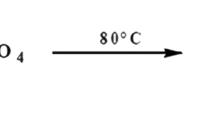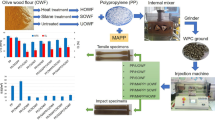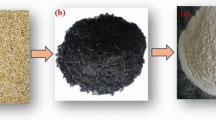Abstract
In this study, the effect of Al2O3 nanoparticles on the heat-transfer properties of medium density fiberboard (MDF) was investigated. Al2O3 nanoparticles were added at two levels (0.5 and 1.0 %) by percentage weight fraction of dry wood fibers to urea formaldehyde (UF) resin. The core temperature profile and thermal conductivity tests showed higher rate of heat transfer after addition of nanoparticles, subsequently it has improved the bonding strength of MDF. Differential scanning calorimetry was used to estimate the heat evolved during the exothermic reaction of UF resin curing. Scanning electron microscopy shows good dispersion of nanoparticles. Thermal conductivity of UF resin improved after nanoparticles addition proved by KD2 pro results. Modulus of rupture, modulus of elasticity and thickness swelling also improved.
Zusammenfassung
In dieser Studie wird der Einfluss von Al2O3 Nanopartikeln auf die Wärmedurchgangseigenschaften von mitteldichten Faserplatten (MDF) untersucht. Al2O3 Nanopartikel wurden in zwei unterschiedlichen Mengen (0,5 % und 1,0 %) bezogen auf das Spantrockengewicht zum Harnstoffharz zugegeben. Prüfungen der Kerntemperatur und der Wärmeleitfähigkeit ergaben eine höhere Wärmedurchgangsrate nach Zugabe von Nanopartikeln und eine Verbesserung der Klebfestigkeit von MDF. Mittels Differenzialrasterkalorimetrie wurde die während der exothermischen Reaktion bei der Härtung von Harnstoffharz abgegebene Wärme geschätzt. Rasterelektronenmikroskopie zeigte eine gute Verteilung der Nanopartikel. Messungen mit dem KD2 pro Gerät belegen, dass sich die Wärmeleitfähigkeit von Harnstoffharz nach Zugabe der Nanopartikel verbessert hat. Die Biegefestigkeit (MOR), der Elastizitätsmodul (MOE) und die Dickenquellung (TS) verbesserten sich ebenfalls.
Similar content being viewed by others
Explore related subjects
Discover the latest articles, news and stories from top researchers in related subjects.Avoid common mistakes on your manuscript.
1 Introduction
Medium density fiberboard (MDF) is an engineered wood product composed of fine lingo-cellulosic fibers combined with a synthetic resin and subjected to heat and pressure to form panels (Irle and Barbu 2010). To facilitate the chemical reaction and allow for reasonable press times, all production processes in the wood based panel industry employ similar methods of heating the mat. This is done by heated platens which are in contact with the mat surfaces. Heat then flows from the platens through the mat surfaces to the center by conduction (Bolton et al. 1989). Since volumetric heating of the mat is not undertaken, curing of the adhesive does not occur uniformly.
The adhesive is cured first on the mat surface and later in the central region. Most inorganic compounds and organic molecules such as polymers and wood are difficult to set in a vibration or excitation mode as they are poor conductors of heat and electricity. Consequently, the core of the mat attains cure temperature only after a significant amount of time has elapsed since subjected to temperature and pressure. Methods to enhance production by increasing the pressing time at a constant temperature or by increasing the press temperature keeping pressing time constant are followed.
Hot pressing is considered a costly unit operation. Reduced pressing time will have a positive impact on lowering the production costs and increasing the plant production capacity. Several methods have been developed to decrease the pressing time such as shortening closure time, high frequency heating, steam injection, increasing the curing rate of the adhesives, optimizing the press parameters. In the literature, the effect of using a high frequency heating source on mat pressing times has also been reported (Pound 1973; Maloney 1989 and Pereira et al. 2004). Application of nano-based materials opens up new aspects in the field of wood science. The effect of nano-silver impregnation on mechanical properties of heat-treated solid wood was carried by Taghiyari (2011). Taghiyari et al. (2011) studied the effect of nano-silver on the reduction of hot-pressing time. Ashori and Nourbakhsh (2009) studied the efficiency of nanoclay (layered silicate) as reinforcement filler in MDF boards. The efficiency of aluminum oxide nanoparticles as a sorbent for removing residual formaldehyde from urea formaldehyde resin was studied by Dudkin et al. (2006). Most metals are good conductors of heat as the atoms are set in a vibration mode of thermal excitation easily. The thermal properties of nanoparticles open up new possibilities for enhancement of heat transfer when added to the wood composite by mixing it with the resin. Thermal conductivity of the wooden panel can be higher, which can lead to shorter pressing time. As the particles are of nanometer size, the difficulties in sawing, nailing etc. are expected to cause fewer problems.
Hence experiments were conducted to estimate the curing time at a different weight concentration of nanoparticles when mixed with resin and wood fibers. The properties of MDF were estimated with an indirect measurement of the resin curing due to the addition of thermally conductive nanoparticles.
2 Experimental procedure
2.1 Materials
Fresh rubber wood (Hevea brasiliensis) fibers were obtained from Robin Resources (M) Sdn. Bhd. Urea–formaldehyde (UF) liquid resin was obtained from Dynea Malaysia Sdn. Bhd. The viscosity of the UF resin at 30 °C was 178 cp, pH 8.79, density 1.286 kg m−3 and gel time at 100 °C was 36 s. Aluminum oxide (Al2O3) nanoparticles were procured from Sigma Aldrich of 47 nm average particle size.
2.2 Mixing of Al2O3 nanoparticles with UF resin
A bench top overhead mixer IKA®-WERKE, model RW 20 DZM with a speed range of 72–2,000 RPM was used for pre-mixing Al2O3 nanoparticles with the UF resin at 1,800 RPM for 30 min. After mixing the Al2O3 nanoparticles and UF resin in a bench top mixer, the resin mixture samples were subjected to ultra-sonic treatment with NANO-LAB Ultrasonic probe dispersion QS1 system for 1 h for uniform mixing of nanoparticles in UF resin. The percentage weight fraction of Al2O3 nanoparticles were based on the weight fraction of oven dry wood fibers at the two levels 0.5 and 1.0 %.
2.3 Thermal conductivity of UF and UF/Al2O3 resins
The thermal conductivity of liquid UF resin and UF hybrids was calculated by using KS-1 sensor of KD2 Pro. It is a device manufactured by Decagon Devices to measure thermal conductivity of liquid samples. The liquid UF resin and hybrid samples are poured in the vials. The cap of the vial is equipped with a septum allowing direct insertion of the needle into the vial through the cap. In liquid samples, the KS-1 sensor needle was oriented vertically during the measurement to help prevent free convection.
2.4 Differential scanning calorimetry (DSC)
The curing process of UF/Al2O3 resin was investigated using differential scanning calorimetry (DSC, Q1000, TA instruments USA).The UF/Al2O3 resins of 6 mg were placed on T-zero hermetic aluminum crucibles. The samples were heated from 30 to 200 °C in an inert atmosphere of nitrogen, maintained at 50 ml min−1 flow rate, with an identical empty crucible used as a reference in the measurement process.
2.5 Fourier transform infrared spectroscopy
The FTIR transmittance spectra of UF and UF/Al2O3 resins were obtained with Perkin Elmer spectrum 100 in the spectral range of 500–4,000 cm−1 with a resolution of 2 cm−1 and 50 scans.
2.6 Scanning electron microscopy (SEM)
SEM analysis was done by using Phenom™ Scanning Electron Microscope with a magnification range of 24–24,000×, images up to 2,048 × 2,048 pixels to study the nanoparticles distribution in the MDF panels.
2.7 Preparation of MDF panels
The standard laboratory method was followed in the manufacturing of 12 mm thick MDF panels. A rotating drum blender was used for the mixing of wood fibers, Al2O3 nanoparticles and UF resin uniformly. The drum consists of steel dowels arranged in a zigzag pattern which was intended to facilitate tumbling and mixing with 18 RPM rotation speed. The Al2O3 nanoparticles resin mixture was sprayed onto the wood fibers with a spray gun. Then, the resin-sprayed fibers were formed into a 300 mm × 300 mm preformed panel which was then pre-pressed at 1.5 MPa pressure. Finally, the pre-pressed panel was hot-pressed at 180 °C for 360 s with a target thickness of 12 mm having a density of 800 kg m−3. Two sets of panels were prepared for each type of concentration. The first set of boards was used to find out the temperature profile inside the core of the mat during hot pressing and the second set of boards was used to determine the physical and mechanical properties. The experimental parameters such as moisture content of fibres, resin content, pressing time, platen temperature were maintained the same in all experiments. Table 1 gives details of the experiment conducted.
2.8 Measurement of core temperature
The wood fiber mat was pre-pressed to half the thickness of the loose mat. The core temperature was measured by using the three K-type of thermocouples. These thermocouples were attached with data logger for storage of data. The thermocouple wires were kept 50 mm apart from each other. The minor deviations in the values from the thermocouples were due to slight difference in elevation of thermocouples location while hot pressing. The average of the three values was taken for the analysis. Three test specimens were prepared for each type, with 0.0, 0.5 and 1.0 % of nanoparticles.
2.9 Evaluation of MDF panel properties
All the MDF panels were sanded to remove the pre-cured surface layer and then cut into specific size specimens for the investigation of the panel properties. All the specimens were maintained at 60 % relative humidity and 20 °C for 3 weeks in a conditioner and then tested according to British Standards EN: 1993. Following number of samples were taken, for internal bonding (20 samples), thickness swelling (20 samples), modulus of rupture and modulus of elasticity (10 samples) and then their average value was taken for analysis.
3 Results and discussion
Figure 1 shows the development of the core temperature for the boards with Al2O3 nanoparticles and the control board (CB). At the beginning of the press cycle, there was a rapid rise in the core temperature which was due to a steep vapor pressure gradient (Bolton et al. 1989, Gupta 2007) that developed during the period of 15–70 s. At press time phase 70–130 s, a constant temperature in the central plane was observed which was due to phase change occurring in the board. The vapor formed is observed to exit from the edges of the board due to higher vapor pressure formed at the core. From the time period of 130 s, a gradual rise in the central plane was observed which was due to heat conduction in the board. As depicted in Fig. 4, the boards prepared with Al2O3 nanoparticles show higher thermal conductivity in comparison to the control boards.
The FTIR spectrum of the samples is shown in Fig. 2. A strong adsorption peak at 3,367.73 cm−1 was observed in all the samples. It represents the free –NH2 group and the peak intensity increases with the addition of nanoparticles. The peaks between 1,650 and 1,550 cm−1 reveal the presence of amide I, II, C=O, and CH2OH, CH3 group. The peaks between 1,400 and 1,360 cm−1 show the presence of CN group (Siimer et al. 2003). The 1,149 cm−1 peak is attributed to both asymmetric stretch of –N–CH2–N– and symmetric stretch of –C–O–C– of the ether linkage. The UF/Al2O3 resins show the same peaks as in pure UF with a higher order of transmittance intensities. The peak around 900–950 cm−1 is a characteristic peak for Al–O bond. It appeared in the samples containing UF/Al2O3 resins.
DSC measurement results are very useful to estimate the chemical reaction kinetics of the UF resin. Figure 3 shows the DSC thermograph for UF and UF/Al2O3 resins at a heating rate of 15 °C min−1. The values of peak curing temperature and enthalpy of reaction is given in Table 2. It was observed that the peak curing temperature decreases as Al2O3 concentration increases. The enthalpy of reaction (ΔH) of UF resin containing Al2O3 shows increasing amount of heat released in comparison to pure UF. This means that more heat was generated during curing of UF resin. This enthalpy of reaction also contributed to the increase in heat transfer during the hot pressing of MDF.
Figure 4 shows the thermal conductivities of liquid UF and UF/Al2O3 resins. The pure UF resin has a thermal conductivity of 0.399 W mK−1. There is an increase of 2.7 and 3.75 % in the thermal conductivity with increasing weight percentage of Al2O3. Comparison of the internal bonding strengths of the different panels is shown in Fig. 5. The bonding strength increases with Al2O3 concentration which can be due to enhanced curing in the core layer of the mat. There is an increase in the bonding strength of 7.6, and 34.3 % with the loading of 0.5 and 1.0 % weight of nanoparticles as compared to standard panel.
There is no significant difference in MOR values of both types of MDFs as shown in Fig. 6. The MOE of MDF panels increases by 10.9 and 17.2 % of 0.5 % weight fraction and 1 % weight fraction loading of Al2O3 nanoparticles as shown in Fig. 7.
The thickness swelling (TS) is lower in the samples that have better bonding. Figure 8 shows thickness swelling (TS) results for all the samples. There is only slight reduction in TS percentage with the increase in nano particles percentage. The Al2O3 nanoparticles were well dispersed in the MDF panel as shown in Fig. 9. The nanoparticles were attached to wood fibers through the cross-linked UF resin.
4 Conclusion
In this study, Al2O3 nanoparticles were added to UF resin to improve the heat transfer during hot pressing of MDF. The data from thermal conductivity (KD2) and DSC have supported the claim. The mechanical properties such as internal bonding and MOE have also shown the improvement. The heat transfer improved due to the addition of Al2O3 nanoparticles and also from the exothermic curing reaction of UF/Al2O3 resin. The enhanced heat-transfer helped in the curing of UF throughout the mat, particularly in the core, resulting in the improvement of physical and mechanical properties of MDF panels.
References
Ashori A, Nourbakhsh A (2009) Effect of nanoclay as reinforcement filler on the physical and mechanical properties of wood-based composite. J Comp Mater 43(8):1869–1875
Bolton AJ, Humphrey PE, Kavvouras PK (1989) The hot pressing of dry-formed wood-based composites. Part III. Predicted vapor pressure and temperature variation with time, compared with experimental data for laboratory boards. Holzforsch 43(4):265–274
Dudkin BN, Krivoshapkin VP, Krivoshapkina EF (2006) Effect of aluminium oxide nanoparticles on the properties of urea-formaldehyde resin. Russ J Appl Chem 79(9):1522–1525
Gupta A (2007) Modelling and optimisation of MDF hot pressing. PhD Thesis. University of Canterbury, New Zealand
Irle M, Barbu MC (2010) Wood-based panel technology. In: Heiko T (ed) Wood based panels: an introduction for specialists. Brunel university press, London, pp 1–90
Maloney T (1989) Modern particleboard and dry-process fiber-board manufacturing. Miller Freeman Publications, San Francisco
Pereira CMC, Blanchard C, Carvalho LMH, Costa CAV (2004) High frequency heating of medium density fiberboard (MDF): theory and experiment. Chem Eng Sci 59(4):735–745
Pound J (1973) Radio frequency heating in the timber industry. William Clowes, England
Siimer K, Kaljuvee T, Christjanson P (2003) Thermal behavior of urea formaldehyde resins curing curing. J Therm Anal Calorim 72:607–617
Taghiyari HR (2011) Study on the effect of nano-silver impregnation on mechanical properties of heat-treated Poplus nigra. Wood Sci Technol 45:399–404
Taghiyari HR, Rangavar H, Farajpour Bibalan O (2011) Effect of nano-silver on the reduction of hot pressing time and improvement in physical and mechanical properties of particleboard. Bioresource 6(4):4067–4075
Acknowledgments
The financial support (RDU: 100313) of University Malaysia Pahang is gratefully acknowledged. The authors acknowledge the support by M/s Robin Resources (M) Sdn. Bhd. for supplying rubber wood fibers and M/s Dynea Malaysia Sdn. Bhd. (171040-P) for supplying urea formaldehyde resin used for conducting the experiments.
Author information
Authors and Affiliations
Corresponding author
Rights and permissions
About this article
Cite this article
Kumar, A., Gupta, A., Sharma, K.V. et al. Use of aluminum oxide nanoparticles in wood composites to enhance the heat transfer during hot-pressing. Eur. J. Wood Prod. 71, 193–198 (2013). https://doi.org/10.1007/s00107-013-0664-9
Received:
Published:
Issue Date:
DOI: https://doi.org/10.1007/s00107-013-0664-9













